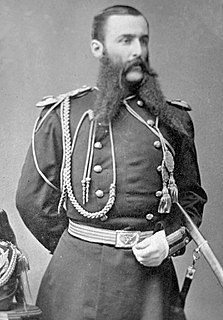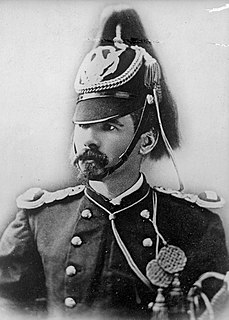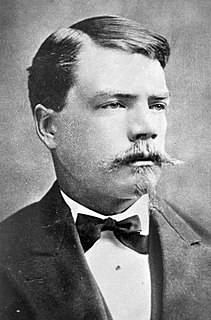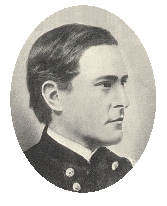 W
WThe Battle of the Little Bighorn, known to the Lakota and other Plains Indians as the Battle of the Greasy Grass and also commonly referred to as Custer's Last Stand, was an armed engagement between combined forces of the Lakota, Northern Cheyenne, and Arapaho tribes and the 7th Cavalry Regiment of the United States Army. The battle, which resulted in the defeat of U.S. forces, was the most significant action of the Great Sioux War of 1876. It took place on June 25–26, 1876, along the Little Bighorn River in the Crow Indian Reservation in southeastern Montana Territory.
 W
WFrederick William Benteen was a military officer who first fought during the American Civil War. He was appointed to commanding ranks during the Indian Campaigns and Great Sioux War against the Lakota and Northern Cheyenne. Benteen is best known for being in command of a battalion of the 7th U. S. Cavalry at the Battle of the Little Bighorn in late June, 1876.
 W
WBloody Knife was an American Indian who served as a scout and guide for the U.S. 7th Cavalry Regiment. He was the favorite scout of Lieutenant Colonel George Armstrong Custer and has been called "perhaps the most famous Native American scout to serve the U.S. Army."
 W
WMitch Boyer was an interpreter and guide in the Old West following the American Civil War. General John Gibbon called him "next to Jim Bridger, the best guide in the country". He was killed at the Battle of the Little Bighorn.
 W
WJames Calhoun was a soldier in the United States Army during the American Civil War and the Black Hills War. He was the brother-in-law of George Armstrong Custer and was killed along with Custer in the Battle of the Little Bighorn. His brother-in-law Myles Moylan survived the battle as part of the forces with Major Marcus Reno and Captain Frederick Benteen.
 W
WWilliam Winer Cooke was a military officer in the United States Army during the American Civil War and the Black Hills War. He was the adjutant for George Armstrong Custer and was killed during the Battle of the Little Bighorn.
 W
WCrazy Horse ; was a Lakota war leader of the Oglala band in the 19th century. He took up arms against the United States federal government to fight against encroachment by white American settlers on Native American territory and to preserve the traditional way of life of the Lakota people. His participation in several famous battles of the Black Hills War on the northern Great Plains, among them the Fetterman Fight in 1866 in which he acted as a decoy and the Battle of the Little Bighorn in 1876 in which he led a war party to victory, earned him great respect from both his enemies and his own people.
 W
WAshishishe, known as Curly and Bull Half White, was a Crow scout in the United States Army during the Sioux Wars, best known for having been one of the few survivors on the United States side at the Battle of Little Bighorn. He did not fight in the battle, but watched from a distance, and was the first to report the defeat of the 7th Cavalry Regiment. Afterward a legend grew that he had been an active participant and managed to escape, leading to conflicting accounts of Curly's involvement in the historical record.
 W
WBoston Custer was the youngest brother of U.S. Army Lt Colonel George Armstrong Custer and two-time Medal of Honor recipient Captain Thomas Custer. He was killed at the Battle of the Little Bighorn along with his two brothers.
 W
WGeorge Armstrong Custer was a United States Army officer and cavalry commander in the American Civil War and the American Indian Wars.
 W
WThomas Ward Custer was a United States Army officer and two-time recipient of the Medal of Honor for bravery during the American Civil War. A younger brother of George Armstrong Custer, he served as his aide at the Battle of Little Bighorn against the Lakota and Cheyenne in the Montana Territory. The two of them, along with their younger brother, Boston Custer, were killed in the overwhelming defeat of United States forces.
 W
WCuster's Last Fight is a 1912 American silent short Western film. It is the first film about George Armstrong Custer and his final stand at the Battle of the Little Bighorn. Francis Ford, the older brother of director John Ford, directed the two-reel short and also starred in the title role. It was shot principally in "Inceville" at Santa Ynez Canyon in Pacific Palisades, California.
 W
WCuster's Last Stand is a 1936 American film serial based on the historical Custer's Last Stand at the Little Bighorn River. It was directed by Elmer Clifton, and starred Rex Lease, William Farnum and Jack Mulhall. It was produced by the Poverty Row studio Stage & Screen Productions, which went bust shortly afterwards as a victim of the Great Depression. This serial stars many famous and popular B-Western actors as well as silent serial star Helen Gibson playing Calamity Jane, Frank McGlynn Jr. as General Custer, and Allen Greer as Wild Bill Hickock.
 W
WCharles Camillo DeRudio was an Italian aristocrat, would-be assassin of Napoleon III, and later a career U.S. Army officer who fought in the 7th U.S. Cavalry at the Battle of the Little Bighorn.
 W
WDr. James Madison DeWolf was an acting assistant surgeon in the U.S. 7th Cavalry Regiment who was killed in the Battle of the Little Big Horn.
 W
WWinfield Scott Edgerly was an officer in the United States Army in the nineteenth and twentieth centuries. Born in New Hampshire in 1846, he attended the United States Military Academy, graduating in 1870. He served on the frontier through the Indian Wars, including the Battle of the Little Big Horn and the Wounded Knee Massacre; in the Spanish–American War; in the Philippine Insurrection; and (briefly) in World War I. He served in several command positions. He was an observer of the Kaiser Maneuvers in Germany in 1907. He was retired as a brigadier general for disability in 1909, was recalled briefly in 1917 and died in 1927. Edgerly is buried at Arlington National Cemetery.
 W
WFrank Finkel was an American who rose to prominence late in his life and after his death for his claims to being the only survivor of George Armstrong Custer's famed "Last Stand" at the Battle of the Little Bighorn on June 25, 1876. Historians disagree over whether Finkel's claim is accurate; although he provided several details that would only have been known by someone who was at Little Bighorn, there are inconsistencies in his accounts of events.
 W
WGall, Lakota Phizí, was a battle leader of the Hunkpapa Lakota in the long war against the United States. He was also one of the commanders in the Battle of Little Bighorn.
 W
WFredric Frances Gerard was a frontiersman, army scout, and civilian interpreter for George Armstrong Custer's 7th U.S. Cavalry during the Little Bighorn Campaign.
 W
WEdward Settle Godfrey was a United States Army Brigadier General who received the Medal of Honor for leadership as a captain during the Indian Wars.
 W
WGoes Ahead was a Crow scout for George Armstrong Custer’s 7th Cavalry during the 1876 campaign against the Sioux and Northern Cheyenne. He was a survivor of the Battle of the Little Big Horn, and his accounts of the battle are valued by modern historians.
 W
WHairy Moccasin was a Crow scout for George Armstrong Custer's 7th Cavalry during the 1876 campaign against the Sioux and Northern Cheyenne. He was a survivor of the Battle of the Little Big Horn.
 W
WHalf Yellow Face was the leader of the six Crow Scouts for George Armstrong Custer's 7th Cavalry during the 1876 campaign against the Sioux and Northern Cheyenne. Half Yellow Face led the six Crow scouts as Custer advanced up the Rosebud valley and crossed the divide to the Little Bighorn valley, and then as Custer made the fateful decision to attack the large Sioux-Cheyenne camp which precipitated the Battle of the Little Bighorn on June 25, 1876. At this time, the other Crow Scouts witnessed a conversation between Custer and Half Yellow Face. Half Yellow Face made a statement to Custer that was poetically prophetic, at least for Custer: "You and I are going home today by a road we do not know".
 W
WLuther Rector Hare was an officer in the 7th U.S. Cavalry, best known for participating in the Battle of the Little Big Horn.
 W
WMark Kellogg was a newspaper reporter killed at the Battle of the Little Bighorn. Kellogg rode with George Armstrong Custer during the battle. His dispatches were the only press coverage of Custer and his men in the days leading up to the battle. As a newspaper stringer whose reports were picked up around the country, Kellogg is considered the first Associated Press correspondent to die in the line of duty.
 W
WMyles Walter Keogh was an Irish soldier. He served in the armies of the Papal States during the war for Italian unification in 1860, and was recruited into the Union Army during the American Civil War, serving as a cavalry officer, particularly under Brig. Gen. John Buford during the Gettysburg Campaign and the three-day Battle of Gettysburg. After the war, Keogh remained in the regular United States Army as commander of I Troop of the 7th Cavalry Regiment under George Armstrong Custer during the Indian Wars, until he was killed along with Custer and all of his men at the Battle of the Little Bighorn in 1876.
 W
WLittle Bighorn Battlefield National Monument preserves the site of the June 25 and 26, 1876, Battle of the Little Bighorn, near Crow Agency, Montana, in the United States. It also serves as a memorial to those who fought in the battle: George Armstrong Custer's 7th Cavalry and a combined Lakota-Northern Cheyenne and Arapaho force. Custer National Cemetery, on the battlefield, is part of the national monument. The site of a related military action led by Marcus Reno and Frederick Benteen is also part of the national monument, but is about 3 miles (5 km) southeast of the Little Bighorn battlefield.
 W
WGeorge Edwin Lord was a U.S. Army Assistant Surgeon in the 7th Cavalry who was killed in the Battle of the Little Big Horn in Montana Territory during the Black Hills War.
 W
WGeorge Loyd, whose last name was occasionally spelled "Lloyd," was a United States Army soldier. He fought in the Battle of the Little Big Horn and in the Battle of Wounded Knee, now called the Wounded Knee Massacre, receiving the Medal of Honor for his actions in the latter.
 W
WMyles Moylan was a United States Army officer who fought at the Battle of the Little Bighorn and received the Medal of Honor. His award came for gallantry during the American Indian Wars.
 W
WHenry Rinaldo Porter was a Surgeon in the 7th U.S. Cavalry at the Battle of the Little Big Horn.
 W
WJames Ezekiel Porter was one of General Custer's eleven officers killed at the Battle of Little Bighorn, also known as Custer's Last Stand, and Porter was among the first verified casualties of the historic battle alerting the world to the demise of Custer's group. According to several historians, Porter led troops in a defensive action at the Little Bighorn. Porter also served in the American South during the Reconstruction Era, where, according to a comrade, he respectably served "Ku Klux" duty while the 7th Cavalry was charged with eradicating the Ku Klux Klan and illegal distilling.
 W
WHenry Armstrong Reed was the nephew of George Armstrong Custer, Thomas Custer, and Boston Custer. Although not an official soldier, he was killed along with them at the Battle of the Little Bighorn at the age of 18.
 W
WMarcus Albert Reno was a United States career military officer who served in the American Civil War where he was a combatant in a number of major battles, and later under George Armstrong Custer in the Great Sioux War against the Lakota (Sioux) and Northern Cheyenne. Reno is most noted for his prominent role in the Battle of the Little Bighorn, where he failed to support Custer's position on the battlefield, remaining instead in a defensive formation with his troops about 4 miles (6.4 km) away. This event has since been a longstanding subject of controversy regarding his command decisions in the course of one of the most infamous defeats in the history of the United States military.
 W
W"Lonesome" Charley Reynolds was a scout in the U.S. 7th Cavalry Regiment who was killed at the Battle of the Little Bighorn in the Montana Territory. He was noted as an expert marksman, frontiersman and hunter. He had also been a scout with Buffalo Bill.
 W
WSitting Bull was a Hunkpapa Lakota leader who led his people during years of resistance against United States government policies. He was killed by Indian agency police on the Standing Rock Indian Reservation during an attempt to arrest him, at a time when authorities feared that he would join the Ghost Dance movement.
 W
WAlgernon Emory Smith was an officer in the U.S. 7th Cavalry Regiment who was killed in the Battle of the Little Bighorn in the Montana Territory.
 W
WThey Died with Their Boots On is a 1941 black-and-white American western film from Warner Bros. Pictures, produced by Hal B. Wallis and Robert Fellows, directed by Raoul Walsh, that stars Errol Flynn and Olivia de Havilland.
 W
WTwo Moons (1847–1917), or Ishaynishus, was one of the Cheyenne chiefs who took part in the Battle of the Little Bighorn and other battles against the United States Army.
 W
WCharles Albert Varnum was a career United States Army officer. He was most noted as the commander of the scouts for George Armstrong Custer in the Little Bighorn Campaign during the Great Sioux War, as well as receiving the Medal of Honor for his actions in a conflict at Drexel Mission following the Wounded Knee Massacre.
 W
WCaptain Thomas Benton Weir was an officer in the 7th Cavalry Regiment, notable for his participation in the Battle of the Little Bighorn, also known as Custer's Last Stand.
 W
WWhite Man Runs Him was a Crow scout serving with George Armstrong Custer's 1876 expedition against the Sioux and Northern Cheyenne that culminated in the Battle of the Little Bighorn.
 W
WWhite Swan (c.1850—1904), or Mee-nah-tsee-us in the Crow language, was one of six Crow Scouts for George Armstrong Custer's 7th Cavalry Regiment during the 1876 campaign against the Sioux and Northern Cheyenne. At the Battle of the Little Bighorn in the Crow Indian Reservation, White Swan went with Major Reno's detachment, and fought alongside the soldiers at the south end of the village. Of the six Crow scouts at the Battle of the Little Bighorn, White Swan stands out because he aggressively sought combat with multiple Sioux and Cheyenne warriors, and he was the only Crow Scout to be wounded in action, suffering severe wounds to his hand/wrist and leg/foot. After being disabled by his wounds, he was taken to Reno's hill entrenchments by Half Yellow Face, the pipe-bearer (leader) of the Crow scouts, which no doubt saved his life.
 W
WGeorge Wilhelmus Mancius Yates was an officer in the U.S. 7th Cavalry Regiment. He was killed in the Battle of the Little Bighorn.